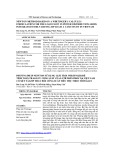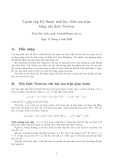
TNU Journal of Science and Technology 229(06): 321 - 329
http://jst.tnu.edu.vn 321 Email: jst@tnu.edu.vn
RESEARCH ON NONLINEAR FREE VIBRATIONS
USING HOMOTOPY ANALYSIS METHOD
Duong The Hung
*
, Nguyen The Thinh
TNU - University of Technology
ARTICLE INFO ABSTRACT
Received:
07/5/2024
This paper applies the homotopy analysis method to study nonlinear
free vibrations. The paper has used the homotopy analysis method to
find analytical solutions of a nonlinear two-degree-of-
freedom system.
Analytical results have found the natura
l oscillation frequencies, the
displacement formula of the system are approximately calculated at the
10th order. Research to find analytical solutions only receives positive
results when selecting the auxiliary parameter ℏ
is the deciding factor
in the va
lues of the solution. Compared with the results calculated by
numerical methods, using calculations by homotopy analysis method is
an advantage to find solutions to the nonlinear vibration problem. From
calculating results, in case of auxiliary parameter ℏ=−0.1
, those
results are matched very well when analyzed by the numerical methods.
In
additionally, to evaluate the reliability of the homotopy analysis
method, this paper has determined that when the time variable is in the
range t = [0→5.4𝜋], the
displacemental results are compared by
calculated by the homotopy method with the numerical method would
be confidence interval.
Revised:
31/5/2024
Published:
31/5/2024
KEYWORDS
Homotopy analysis
Nonlinear
Approximation
Natural frequency
Lateral displacement
NGHIÊN CỨU DAO ĐỘNG TỰ DO PHI TUYẾN SỬ DỤNG PHƯƠNG PHÁP
PHÂN TÍCH ĐỒNG LUÂN
Dương Thế Hùng
*
, Nguyễn Thế Thịnh
Trường Đại học Kỹ thuật Công nghiệp – ĐH Thái Nguyên
THÔNG TIN BÀI BÁO TÓM TẮT
Ngày nhậ
n bài:
07/5/2024
Bài báo này áp d
ụ
ng phương pháp phân tích đ
ồ
ng luân đ
ể
nghiên c
ứ
u
dao động tự do phi tuyến. Bài báo dùng phương pháp phân tích đồ
ng
luân để tìm nghiệm giải tích của hệ hai bậc tự do phi tuyến. Kết quả giả
i
tích đã tìm được tần số dao động riêng, công thức chuyển vị của hệ
được xấp xỉ tính toán ở bậc 10. Việc nghiên cứu tìm nghiệm giả
i tích
chỉ nhận được kết quả khả quan khi lựa chọn tham số phụ ℏ là yếu tố
quuyết định đến giá trị của nghiệm. So sánh với kết quả tính bằ
ng
phương pháp số, sử dụng tính toán bằng phương pháp phân tích đồ
ng
luân là một lợi thế để tìm nghiệm của bài toán dao động phi tuyến. Từ
kết quả tính toán của bài báo, khi tham số phụ ℏ=−0.1 nhận được kế
t
quả trùng khớp với kết quả giải bằng phương pháp số. Ngoài ra, để
đánh giá mức độ tin cậy trong phương pháp phân tích đồ
ng luân, bài
báo đã xác định được khi biến thời gian trong khoảng 𝑡=[0→5.4π]
,
kết quả so sánh về chuyển vị tính bằng phương pháp phân tích đồ
ng
luân với phương pháp số là đáng tin cậy.
Ngày hoàn thiệ
n:
31/5/2024
Ngày
đăng:
31/5/2024
TỪ KHÓA
Phân tích đồng luân
Phi tuyến
Xấp xỉ
Tần số tự nhiên
Chuyển vị ngang
DOI: https://doi.org/10.34238/tnu-jst.10308
* Corresponding author. Email: hungtd@tnut.edu.vn

TNU Journal of Science and Technology 229(06): 321 - 329
http://jst.tnu.edu.vn 322 Email: jst@tnu.edu.vn
1. Introduction
Nonlinear
vibration
problems
cannot
always
be
solved
with
analytical
solutions,
especially
problems
with
high
nonlinearity.
Research
on
solving
nonlinear
vibration
problems
using
analytical methods has been discussed by many authors [1] - [5]. The authors [1] – [3], [5] used
the perturbation method; the asymptotic method was used in [4]; the homotopy analysis method
(HAM)
was
used
in
[6]
–
[10]
and
the
homotopy
perturbation
method
was
used
in
[9]
–
[13].
Solving
the
nonlinear
vibration
problem
by
analytical
methods
with
perturbation
direction
and
asymptotic methods requires that a small parameter exists in the equation, from which the series
can
be
expanded
according
to
that
small
parameter
[1]
-
[5].
However,
depending
on
small
parameters
sometimes
makes
it
difficult
to
find
solutions
to
highly
nonlinear
differential
equations. Therefore, choosing an analytical method to solve highly nonlinear problems requires
something worth paying attention to when choosing a solution method.
With the introduction of the homotopy analysis method [6] - [10], it is one of the methods for
finding
analytical
solutions
of
the
nonlinear
vibration
problem
with
certain
advantages.
The
outstanding advantage is that there is no need for small parameters in the equation, so it can be
applied
to
nonlinear
problems
in
the
most
natural
way.
The
characteristic
of
the
homotopy
analysis method is to build a class of problems with the participation of the embedded parameter
q = [0,1], from which to build functions and variables in the form of power series expansions of
the embedded parameter q.
Applying
the
homotopy
analysis
method
(HAM)
to
solving
nonlinear
problems
sometimes
requires knowing how to flexibly select input factors appropriate to the problem to be solved, so
to get
positive
results
requires a considerable
experience
and
skills.
The input
requirements are
formula representing the rule of solution expression, choozing the initial approximation, building
the linear auxiliary operator, the auxiliary parameter ℏ, and the auxiliary function. The received
results are also an expression containing the auxiliary parameter ℏ, so to find a suitable solution
for the original nonlinear problem, it is necessary to see at what value of the auxiliary parameter
the received series will converge to get the required result.
In
this
paper,
the
homotopy
analysis
method
has
been
applied
to
analyze
the
problem
of
nonlinear
free
vibration
for
a
two-degree-of-freedom
system,
thereby
determining
the
solution
expression
as
two
horizontal
displacements
u1(t)
and
u2(t),
and
at
the
same
time
received
the
natural
oscillation
frequency
ω.
The
results
show
that
corresponding
to
the
value
ℏ
=
−0.1,
results
consistent
with
the
original
nonlinear
problem
are
obtained.
When
the
value
of
the
auxiliary
parameter
ℏ
=
[−0.15
→
0.04],
the
series
converges
to
the
solution
of
the
problem
corresponding to the 10th order solution.
By applying the homotopy method to find the solution of the nonlinear vibration problem, this
paper has obtained the solution expression of the problem by series expansion at the 10th order.
The
paper
have
already
compared
the
results
of
applying
by
HAM
with
the
numeric
method
results. The results were evaluated with the confidence interval of the homotopy analysis method.
The
contents
of
this
paper
consist
of
sections:
1.
Introduction;
2.
The
method
of
vibration
analysis; 3. Results and discussion; 4. Conclusions.
2. The method of vibration analysis
In the article [14], the author models a 2-storey house structure described by a two-degree-of-
freedom
nonlinear
vibration
equation,
with
the
unknowns
being
two
horizontal
displacements
𝑢(𝑡),
𝑢(𝑡). To solve the problem of undamped free oscillation, we get the following equation:
𝑢
+
𝜒𝑢
+
4𝛾𝑢
+
2𝛾𝑢𝑢
=
0
𝑢+𝜒𝑢+4𝛾𝑢
=0 (1)
with the boundary conditions:
𝑢(0)=𝑎; 𝑢(0)=0; 𝑢(0)=−𝑏;𝑢(0)=0 (2)

TNU Journal of Science and Technology 229(06): 321 - 329
http://jst.tnu.edu.vn 323 Email: jst@tnu.edu.vn
In the equations (1) the parameters χ,χ,γ, γ,γ are given values. In this article, we will
not survey the change of these parameters to the results of 𝑢(𝑡),𝑢(𝑡) because we will receive
the solution expression containing those parameters. Our task now is to solve the nonlinear
differential equation (1) by using analytical methods, that is, to find two horizontal displacements
𝑢(𝑡),𝑢(𝑡).
Rewrite equations (1) as following:
2
3 2
1
11 1 1 1 3 1 2
2
2
3
2
22 2 5 2
2
4 2 0;
4 0
d u u u u u
dt
d u u u
dt
(3)
Use transformations: 𝜏=𝜔𝑡,𝑢(𝜏)=𝑢(𝑡),𝑢(𝑡)=𝛿𝑣(𝜏),
=
=𝜔
,
=𝜔
, (4)
Equations (3) becomes:
𝜔
+𝜒𝑢+4𝛾𝑢+2𝛾𝛿𝑢𝑣=0
𝜔
+𝜒𝑢+4𝛾𝛿𝑣=0 (5)
The boundary conditions in equations (2) have been chosen a0=1, b0=1, then equations (2)
become: 𝑢(0)=1,𝑢(0)=0,
𝑣(0)=−1,𝑣(0)=0, (6)
Thus, the original nonlinear equations (1) with two unknowns - two displacements 𝑢(𝑡) and
𝑢(𝑡) have been replaced by solving equations (5) with two new displacements 𝑢(τ), 𝑣(τ) and
two unknown parameters ω,δ. The following section uses the homotopy analysis method (HAM)
to find approximate analytical solutions for equation (5) with boundary condition (6).
To apply the HAM to solve the system of nonlinear equations (5) with boundary conditions
(6), we choose the solution expression form as:
𝑢(𝜏)=𝑢(𝜏)+∑ [𝑎𝑐𝑜𝑠(2𝑛+1)𝜏]
,𝑣(𝜏)=𝑣(𝜏)+∑ [𝑏𝑐𝑜𝑠(2𝑛+1)𝜏]
(7)
in which the initial approximation solution is chosen to satisfy the boundary condition (6):
𝑢(𝜏)=𝑐𝑜𝑠(𝜏),𝑣(𝜏)=−𝑐𝑜𝑠(𝜏), (8)
According to the HAM, choose the auxiliary linear operator as:
ℑ[𝛷(𝜏;𝑞)]=(;)
+𝛷(𝜏;𝑞),ℑ[𝛩(𝜏;𝑞)]=(;)
+𝛩(𝜏;𝑞) (9)
with the property: ℑ[𝐶𝑠𝑖𝑛𝜏+𝐶𝑐𝑜𝑠𝜏]=0 (10)
In order to solve equations (5) by the HAM, we define the nonlinear operator:
ℵ[𝛷(𝜏;𝑞),𝛩(𝜏;𝑞),𝛺(𝑞),𝛥(𝑞)]=
=𝛺(𝑞)(;)
+𝜒𝛷(𝜏;𝑞)+4𝛾(𝛷(𝜏;𝑞))+2𝛾(𝛥(𝑞))𝛷(𝜏;𝑞)(𝛩(𝜏;𝑞)) (11)
ℵ[𝛷(𝜏;𝑞),𝛩(𝜏;𝑞),𝛺(𝑞),𝛥(𝑞)]=
=𝛺(𝑞)(;)
+𝜒𝛥(𝑞)𝛩(𝜏;𝑞)+4𝛾(𝛥(𝑞))(𝛩(𝜏;𝑞)) (12)
where
( ;q), ( ; )
q
is a function of 𝜏 and q; 𝛺(𝑞),𝛥(𝑞) is a function of embedding
parameter q (0≤q≤1). Let ℏ,ℏ are auxiliary parameters not equal to zero, then to construct the
zero-order deformation equations as following:
(1−𝑞)ℑ[𝛷(𝜏;𝑞)−𝑢(𝜏)]=𝑞ℏℵ[𝛷(𝜏;𝑞),𝛩(𝜏;𝑞),𝛺(𝑞),𝛥(𝑞)]
(1−𝑞)ℑ[𝛩(𝜏;𝑞)−𝑣(𝜏)]=𝑞ℏℵ[𝛷(𝜏;𝑞),𝛩(𝜏;𝑞),𝛺(𝑞),𝛥(𝑞)] (13)
will match with initial boundary conditions:

TNU Journal of Science and Technology 229(06): 321 - 329
http://jst.tnu.edu.vn 324 Email: jst@tnu.edu.vn
𝛷(0;𝑞)=𝑎,𝜕𝛷(𝜏;𝑞)
𝜕𝜏 =0
𝛩(0;𝑞)=𝑏,(;)
=0 (14)
When q=0, from the zero-order deformation equations we get:
𝛷(𝜏;0)=𝑢(𝜏),𝛩(𝜏;0)=𝑣(𝜏), (15)
When q=1, from the zero-order deformation equations we get:
𝛷(𝜏;1)=𝑢(𝜏),𝛩(𝜏;1)=𝑣(𝜏),𝛥(1)=𝛿,𝛺(1)=𝜔 (16)
By Taylor’s theorem, we expand
( ;q), ( ;q), (q), (q)
in a power series of the embedding
parameter q as following:
𝛷(𝜏;𝑞)=𝑢(𝜏)+∑𝑢(𝜏)𝑞
,𝛩(𝜏;𝑞)=𝑣(𝜏)+∑𝑣(𝜏)𝑞
(17)
𝛺(𝑞)=𝜔+∑𝜔(𝜏)𝑞
,𝛥(𝑞)=𝛿+∑𝛿(𝜏)𝑞
(18)
when q=1, those series converge and then get:
𝑢(𝜏)=𝑢(𝜏)+∑𝑢(𝜏)
,𝑣(𝜏)=𝑣(𝜏)+∑𝑣(𝜏)
(19)
𝜔=𝜔+∑𝜔(𝜏)
,𝛿=𝛿+∑𝛿(𝜏)
(20)
In the equations (17), (18), denote the following quantities:
𝑢(𝜏)=
!(;)
,𝑣=
!()
(21)
𝛿=
!()
,𝜔=
!()
, (22)
From the zero-order deformation equations (13), the mth-order derivative with respect to
embedding parameter q we will get the mth-order deformation equation:
ℑ[𝑢(𝜏)−𝜆𝑢(𝜏)]=ℏ𝑅
(𝑢
,𝑣,𝜔
,𝛿)
ℑ[𝑣(𝜏)−𝜆𝑣(𝜏)]=ℏ𝑅
(𝑢
,𝑣,𝜔
,𝛿) (23)
subject to the initial conditions:
𝑢(0)=0,𝑢
(0)=0,𝑣(0)=0,𝑣
(0)=0, (24)
where 𝜆=0(𝑚<=1),𝜆=1(𝑚>1), ℏ,ℏ- auxiliary parameters. When implemented
by the HAM, ℏ,ℏ are meaningful to determine the convergence region of the series (17), (18).
The right-hand side of equation (23) is written as the m-1 order derivative with respect to q:
𝑅
(𝑢
,𝑣,𝜔
,𝛿)= 1
(𝑚−1)!𝑑ℵ[𝛷(𝜏;𝑞),𝛩(𝜏;𝑞),𝛺(𝑞),𝛥(𝑞)]
𝑑𝑞
𝑅
(𝑢
,𝑣,𝜔
,𝛿)=
()!ℵ[(;),(;),(),()]
(25)
in equation (25) use symbols:
𝑢
=(𝑢
,𝑢
,...,𝑢
),𝑣=(𝑣,𝑣,...,𝑣),𝜔
=(𝜔
,𝜔
,...,𝜔
),𝛿=(𝛿,𝛿,...,𝛿) (26)
From the assumption that the solution expression is written as equation (7), then the right side
of equation (25) is written as:
𝑅
(𝑢
,𝑣,𝜔
,𝛿)= 𝑎,(𝜔
,𝛿)𝑐𝑜𝑠[(2𝑛+1)𝜏]
()
𝑅
(𝑢
,𝑣,𝜔
,𝛿)=∑𝑏,(𝜔
,𝛿)𝑐𝑜𝑠[(2𝑛+1)𝜏]
()
(27)
From equations (23), the solution expression is written by:
𝑢(𝜏)=𝜆𝑢(𝜏)+ℏ𝑎,(𝜔
,𝛿)
(1−𝑛)𝑐𝑜𝑠[(2𝑛+1)𝜏]
()
𝑣(𝜏)=𝜆𝑣(𝜏)+ℏ∑,(
,
)
()𝑐𝑜𝑠[(2𝑛+1)𝜏]
()
(28)
The mth-order approximation solution M, will get as:

TNU Journal of Science and Technology 229(06): 321 - 329
http://jst.tnu.edu.vn 325 Email: jst@tnu.edu.vn
𝑢(𝜏)≈∑𝑢(𝜏)
,𝑣(𝜏)≈∑𝑣(𝜏)
(29)
𝜔≈∑𝜔(𝜏)
,𝛿≈∑𝛿(𝜏)
(30)
Finally, we will get the displacements of the original equation (1):
𝑢(𝜏)=𝑢(𝜔𝑡)=∑𝑢(𝜔𝑡)
,𝑢(𝜏)=𝛿𝑣(𝜔𝑡)=∑𝛿
∑𝑢(𝜔𝑡)
(31)
3. Results and discussion
With the initial approximation solution 0 0
u ( ) cos( ), ( ) cos( ),
v
parametes 𝜔,𝛿 can be
calculated by the following equations as:
𝜔=±()
(),𝛿=±()
() (32)
and also get the first-order approximation solution as:
𝑢(𝜏)=ℏ
(2𝛾+𝛾𝛿)(𝑐𝑜𝑠𝜏−𝑐𝑜𝑠3𝜏),𝑣(𝜏)=−ℏ
𝛾𝛿(𝑐𝑜𝑠𝜏−𝑐𝑜𝑠3𝜏), (33)
For higher order approximations we also get the same instinctive formula as above. But,
because expressing them is very long, to make it easier to see the higher order approximations,
here assigned the parameters in the original nonlinear equation systems (1) as values of 𝜒 =
5.013226625,𝜒 =2.466371557,𝛾=1,𝛾=1,𝛾=1, ℏ=−0.1,ℏ=−0.1, thereby
obtaining approximate values for the first three orders as shown in Table 1.
Table 1. Calculated results by HAM with the first three orders
Order No
𝛚
𝛅
𝒖
(
𝛕
)
𝒗
(
𝝉
)
0
𝑐𝑜𝑠
(
𝜏
)
−
𝑐𝑜𝑠
(
𝜏
)
1 3.682401 -1.922993
−
0
.
03561189611
𝑐𝑜𝑠
(
τ
)
+
0
.
03561189611
𝑐𝑜𝑠
(
3
τ
)
0
.
04622379222
𝑐𝑜𝑠
(
𝜏
)
−
0
.
04622379222
𝑐𝑜𝑠
(
3
τ
)
2 -0.03434 -0.022523
0
.
01021447222
𝑐𝑜𝑠
(
τ
)
−
0
.
01164618673
𝑐𝑜𝑠
(
3
τ
)
+
0
.
001431714505
𝑐𝑜𝑠
(
5
τ
)
−
0
.
01323657449
𝑐𝑜𝑠
(
τ
)
+
0
.
01537321346
𝑐𝑜𝑠
(
3
τ
)
−
0
.
002136638969
𝑐𝑜𝑠
(
5
τ
)
3 0.009879 0.0074637
−
0
.
00347715794
𝑐𝑜𝑠
(
τ
)
+
0
.
00436112291
𝑐𝑜𝑠
(
3
τ
)
−
0
.
000943726937
𝑐𝑜𝑠
(
5
τ
)
+
0
.
00005976196621
𝑐𝑜𝑠
(
7
τ
)
0
.
00437453843
𝑐𝑜𝑠
(
τ
)
−
0
.
00569699132
𝑐𝑜𝑠
(
3
τ
)
+
0
.
001421216446
𝑐𝑜𝑠
(
5
τ
)
−
0
.
00009876355
𝑐𝑜𝑠
(
7
τ
)
1+2
+ 3order 3.657940 -1.938053
0
.
9711254179
𝑐𝑜𝑠
(
τ
)
+
0
.
02832683229
𝑐𝑜𝑠
(
3
τ
)
+
0
.
000487987568
𝑐𝑜𝑠
(
5
τ
)
+
0
.
00005976196621
𝑐𝑜𝑠
(
7
τ
)
−
0
.
9626382438
𝑐𝑜𝑠
(
τ
)
−
0
.
03654757008
𝑐𝑜𝑠
(
3
τ
)
−
0
.
000715422523
𝑐𝑜𝑠
(
5
τ
)
−
0
.
00009876355
𝑐𝑜𝑠
(
7
τ
)
Table 1 shows that the results calculated by HAM are obtained as expression the values of the
variables according to the initial parameters and boundary conditions. Most of the methods for
solving nonlinear equations use other methods that cannot give expressions, but the HAM
method has shown the results of expressions, depending on the level of accuracy of the problem
we are trying to solve to what level. In this paper, we have calculated the results up to the 10th
order, and the results are expressed by solution expressions as in table 1. The obtained results, in
addition to depending on boundary conditions and model parameters 𝜒,𝜒,𝛾,𝛾,𝛾, also
depend on the two auxiliary parameters ℏ,ℏ shown in Table 2.
Figures 1 to 5 are the results on the graph calculated by the HAM and by numerical methods.
Figure 1 shows the numerical results for the original equation (1) with boundary conditions
u1(0)=1, u2(0)= 1.939975786, showing the horizontal axis as t=0→2π, the vertical axis are
two displacements: CV1num is the displacement u1(t) and CV2num is the displacement u2(t).
Figure 2 is the displacement results by HAM of equation (5) with boundary conditions
𝑢(0)=1,𝑣(0)=−1, displaying the horizontal axis as 𝑡=0→2π, vertical axis are two
displacements: CV1 is the displacement 𝑢(τ)=𝑢(ω𝑡) and CV2 is the displacement 𝑢(τ)=
δ𝑣(ω𝑡), with the values δ, ω and 𝑢(τ),𝑣(τ) determined at the 10th iteration and assigned the




















![Bộ câu hỏi lý thuyết Vật lý đại cương 2 [chuẩn nhất/mới nhất]](https://cdn.tailieu.vn/images/document/thumbnail/2025/20251003/kimphuong1001/135x160/74511759476041.jpg)
![Bài giảng Vật lý đại cương Chương 4 Học viện Kỹ thuật mật mã [Chuẩn SEO]](https://cdn.tailieu.vn/images/document/thumbnail/2025/20250925/kimphuong1001/135x160/46461758790667.jpg)




